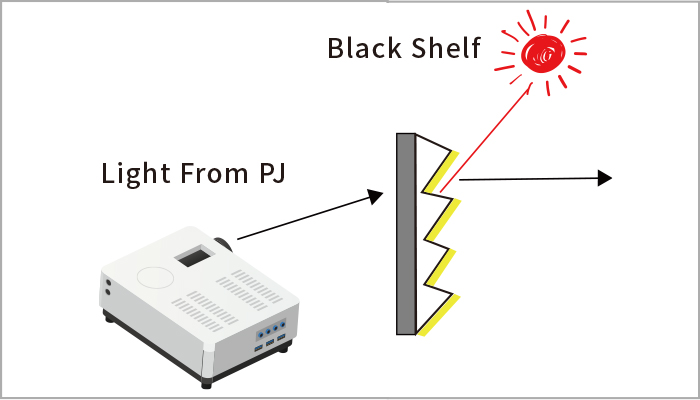An ambient light rejecting screen blocks more than 80% of environmental light, making it an effective solution for bright environments.
Common principles involve precise microstructure processing and special coating techniques to absorb and block ambient light, preventing it from reflecting into the viewer's eyes and enhancing contrast in bright rooms.


It enhances the contrast and color vibrancy of the projected image, making it ideal for use in bright environments.
A good projection screen must have three key attributes: brightness gain (Gain), contrast, and viewing angle.
Among these, improving contrast in lit environments is the most challenging, which is why most projection screens require the lights to be turned off during use.
Contrast refers to the comparison between white and black areas on the screen. Higher contrast results in clearer images. Since projectors cannot produce black light, the screen plays a crucial role in achieving this effect.
IFT Technology utilizes advanced processing techniques, proprietary material research, and multiple screen patents to produce eco-friendly screens that protect eye health and provide an unparalleled viewing experience.

(Official certification for reference)


Based on the configuration of the projector and screen, there are three main types: front projection, rear projection, and ultra-short throw projection.



IFT Technology develops different ambient light rejecting screens for various projection methods. Feel free to contact us for demonstrations and recommendations for the most suitable screen.
All screens manufactured by IFT comply with EU RoHS & REACH green environmental regulations for safe use:
| Screen Product | Description |
|---|---|
| CBSP, HBSP | Ultra-short throw screens made of multi-layer composite materials with PET as the base for excellent flatness. TPU microstructures ensure uniform reflection of projection light, and the ambient light blocking layer effectively blocks environmental light. |
| CBSPU-H | Ultra-short throw screens made of multi-layer composite materials with PET as the base for excellent flatness. UV microstructures enhance image detail, and the surface ambient light blocking layer effectively blocks environmental light. |
| HBSi | Ultra-short throw screens with the latest patented technology. PET base ensures excellent flatness, TPU microstructures, and special coating techniques significantly enhance screen brightness. The ambient light blocking layer effectively blocks environmental light, increasing contrast in bright rooms. |
| LLUA | Front projection ceiling-mounted screens with thin PET base for excellent flatness and rollability, suitable for roll-up screens. UV louver design provides a viewing angle >170°, and AG anti-glare treatment prevents surface reflection, maintaining excellent visual effects and clarity. |
| LUGS | Front projection tabletop screens made of PET + UV photosensitive resin composite ambient light blocking materials. High refractive index glass beads enhance screen brightness, providing soft and clear images. |
Comparison of power consumption between a 100-inch LED TV and a 100-inch projector.
Typical large LED TVs consume about 550~750W, while 2000~3000-lumen ultra-short throw laser projectors consume about 250~350W, resulting in approximately twice the energy efficiency.
The choice between a TV and a projector ultimately depends on your eyes.
Do you find it hard to sleep after watching TV or using your phone before bed? This phenomenon, known as "digital eye strain" or "computer vision syndrome," is caused by blue light emitted from screens, which can harm your eyes over time.
Most people spend about 10 hours a day in front of screens, whether working on computers, using phones, or watching TV. This lifestyle increases the risk of digital eye strain.
While laser projectors also emit blue light, the light does not directly enter the eyes. Instead, it is projected onto the screen, with some light refracted or diffused into the environment and some reflected into the eyes. This indirect light is softer, significantly reducing blue light exposure and the likelihood of digital eye strain.